

Compact Muon Solenoid
LHC, CERN
| CMS-HIN-18-001 ; CERN-EP-2018-345 | ||
| Charged-particle angular correlations in XeXe collisions at ${\sqrt {\smash [b]{s_{_{\mathrm {NN}}}}}} = $ 5.44 TeV | ||
| CMS Collaboration | ||
| 23 January 2019 | ||
| Phys. Rev. C 100 (2019) 044902 | ||
| Abstract: Azimuthal correlations of charged particles in xenon-xenon collisions at a center-of-mass energy per nucleon pair of $ {\sqrt {\smash [b]{s_{_{\mathrm {NN}}}}}} = $ 5.44 TeV are studied. The data were collected by the CMS experiment at the LHC with a total integrated luminosity of 3.42 $\mu$b$^{-1}$. The collective motion of the system formed in the collision is parameterized by a Fourier expansion of the azimuthal particle density distribution. The azimuthal anisotropy coefficients $v_{2}$, $v_{3}$, and $v_{4}$ are obtained by the scalar-product, two-particle correlation, and multi-particle correlation methods. Within a hydrodynamic picture, these methods have different sensitivities to non-collective and fluctuation effects. The dependence of the Fourier coefficients on the size of the colliding system is explored by comparing the xenon-xenon results with equivalent lead-lead data. Model calculations that include fluctuation effects are also compared to the experimental results. The observed angular correlations provide new constraints on the hydrodynamic description of heavy ion collisions. | ||
| Links: e-print arXiv:1901.07997 [hep-ex] (PDF) ; CDS record ; inSPIRE record ; HepData record ; CADI line (restricted) ; | ||
| Figures | |
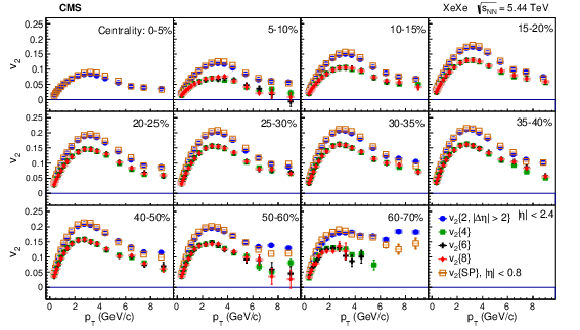
png pdf |
Figure 1:
Elliptic-flow coefficients, $v_2$, based on different analysis techniques, as functions of transverse momentum and in bins of centrality, from the 5% most central (top left) to 60-70% centrality (bottom right). The results for the two-particle and multi-particle correlations correspond to the range $ {| \eta |} < $ 2.4, while the SP results are for $ {| \eta |} < $ 0.8. The bars and the shaded boxes represent statistical and systematic uncertainties, respectively. |

png pdf |
Figure 2:
Triangular-flow coefficients, $v_3$, based on the different analysis techniques, as functions of transverse momentum and in bins of centrality, from the 5% most central (top left) to 60-70% centrality (bottom right). The results for the two-particle and multi-particle correlations correspond to the range $ {| \eta |} < $ 2.4, while the SP results are for $ {| \eta |} < $ 0.8. The bars and the shaded boxes represent statistical and systematic uncertainties, respectively. |
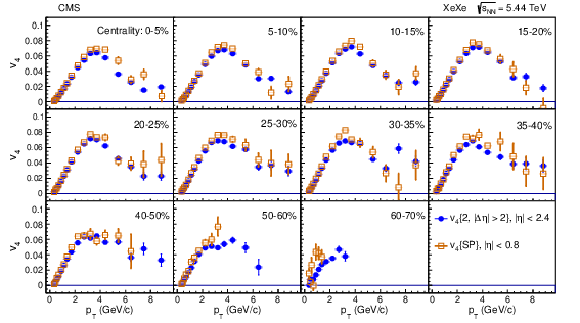
png pdf |
Figure 3:
The $v_4$ coefficients, based on the different analysis techniques, as functions of transverse momentum and in bins of centrality, from the 5% most central (top left) to 60-70% centrality (bottom right). The results for the two-particle correlations correspond to the range $ {| \eta |} < $ 2.4, while the SP results are for $ {| \eta |} < $ 0.8. The bars and the shaded boxes represent statistical and systematic uncertainties, respectively. |

png pdf |
Figure 4:
Centrality dependence of the spectrum-weighted $v_2$, $v_3$, and $v_4$ flow harmonics with 0.3 $ < {p_{\mathrm {T}}} < $ 3.0 GeV/$c$. The $v_2$ results are shown for 2-, 4-, 6-, and 8-particle correlations (left panel). The $v_3$ results are shown for 2- and 4-particle correlations (middle panel), while the $v_4$ values are presented for two-particle correlations technique, only. The magenta line in each panel is the IP-Glasma+music+UrQMD prediction for $v_n\{2, {| \Delta \eta |} > 2\}$. The shaded boxes represent systematic uncertainties. |
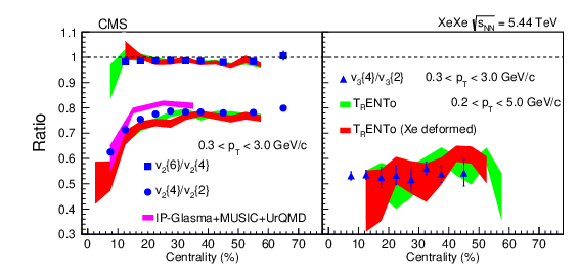
png pdf |
Figure 5:
Centrality dependence of $v_2\{4\}/v_2\{2\}$, $v_2\{6\}/v_2\{4\}$ (left panel) and $v_3\{4\}/v_3\{2\}$ (right panel) ratios. The colored areas represent the theoretical predictions based on the IP-Glasma+music+UrQMD and the relativistic hydrodynamic model from Ref. [35] considering both spherical and deformed xenon nuclei, while the widths of the areas show the statistical uncertainties of the model. The $\mathrm {T_RENTo}$ calculation is done for the ${p_{\mathrm {T}}}$ range 0.2 $ < {p_{\mathrm {T}}} < $ 5.0 GeV/$c$. |
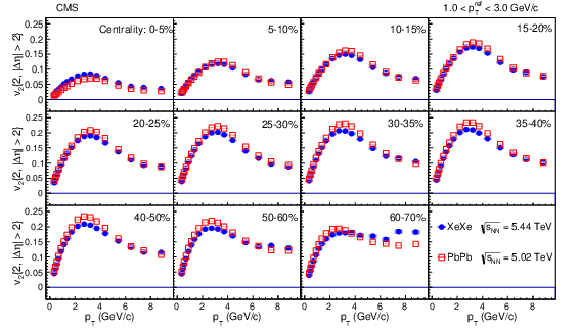
png pdf |
Figure 6:
Comparison of the $v_2$ results measured with two-particle correlations from two different systems, XeXe collisions at $ {\sqrt {\smash [b]{s_{_{\mathrm {NN}}}}}} = $ 5.44 TeV and PbPb collisions at 5.02 TeV, shown as a function of ${p_{\mathrm {T}}}$ in eleven centrality bins. The bars (smaller than the marker size) and the shaded boxes represent statistical and systematic uncertainties, respectively. |
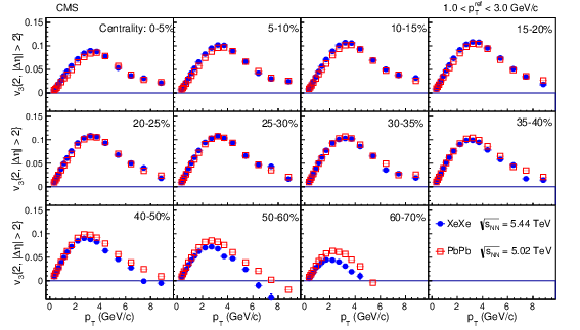
png pdf |
Figure 7:
Comparison of the $v_3$ results measured with two-particle correlations from two different systems, XeXe collisions at $ {\sqrt {\smash [b]{s_{_{\mathrm {NN}}}}}} = $ 5.44 TeV and PbPb collisions at 5.02 TeV, shown as a function of ${p_{\mathrm {T}}}$ in eleven centrality bins. The bars (smaller than the marker size) and the shaded boxes represent statistical and systematic uncertainties, respectively. |
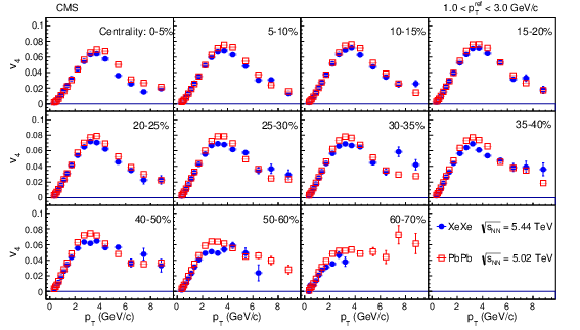
png pdf |
Figure 8:
Comparison of the $v_4$ results measured with two-particle correlations from two different systems, XeXe collisions at $ {\sqrt {\smash [b]{s_{_{\mathrm {NN}}}}}} = $ 5.44 TeV and PbPb collisions at 5.02 TeV, shown as a function of ${p_{\mathrm {T}}}$ in eleven centrality bins. The bars and the shaded boxes represent statistical and systematic uncertainties, respectively. |
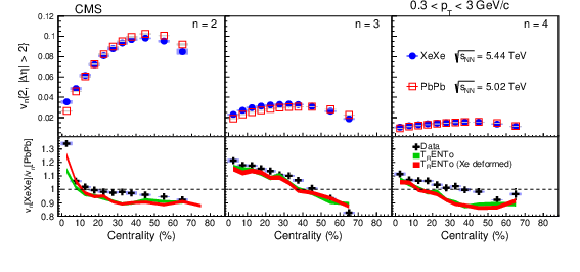
png pdf |
Figure 9:
Centrality dependence of the spectrum-weighted $v_2$, $v_3$, and $v_4$ harmonic coefficients from two-particle correlations method for 0.3 $ < {p_{\mathrm {T}}} < $ 3.0 GeV/$c$ for XeXe collisions at $ {\sqrt {\smash [b]{s_{_{\mathrm {NN}}}}}} = $ 5.44 TeV and PbPb collisions at 5.02 TeV. The lower panels show the ratio of the results for the two systems. The bars and the shaded boxes represent statistical and systematic uncertainties, respectively. Theoretical predictions from Ref. [35] are compared to the data (colored area). The model calculation is done for the ${p_{\mathrm {T}}}$ range 0.2 $ < {p_{\mathrm {T}}} < $ 5.0 GeV/$c$. |

png pdf |
Figure 10:
Ratios of the $v_2$, $v_3$, and $v_4$ harmonic coefficients from two-particle correlations in XeXe and PbPb collisions as functions of ${p_{\mathrm {T}}}$ in eleven centrality bins. The bars and the shaded boxes represent statistical and systematic uncertainties, respectively. |
| Summary |
| In this paper, the $v_2$, $v_3$, and $v_4$ azimuthal flow harmonics are shown for xenon-xenon (XeXe) collisions at a center-of-mass energy per nucleon pair of ${\sqrt {\smash [b]{s_{_{\mathrm {NN}}}}}} = $ 5.44 TeV based on data obtained with the CMS detector. Three analysis techniques with different sensitivities to flow fluctuations, including two-particle correlations, the scalar-product method, and the multi-particle cumulant method, are used to explore the event-by-event fluctuations. The harmonic coefficients are compared to those found with lead-lead (PbPb) collisions at ${\sqrt {\smash [b]{s_{_{\mathrm {NN}}}}}} = $ 5.02 TeV to explore the effect of the system size. The magnitude of the $v_2$ coefficients for XeXe collisions are larger than those found in PbPb collisions for the most central collisions. This is attributed to a larger fluctuation component in the lighter colliding system. In more peripheral events, the PbPb $v_n$ coefficients are consistently larger than those found for XeXe collisions. This behavior is qualitatively consistent with expectations from hydrodynamic models. A clear ordering $v_2\{2\} > v_2\{4\} \approx v_2\{6\} \approx v_2\{8\}$ is observed for XeXe collisions, with $v_2\{6\}$ and $v_2\{4\}$ values differing by 2-3%. The $v_3\{4\} / v_3\{2\}$ ratio is found to be significantly smaller than the $v_2\{4\} / v_2\{2\}$ ratio, suggesting a dominant fluctuation component for the $v_3$ harmonic. Hydrodynamic models that consider the xenon nuclear deformation are able to better describe the $v_{2}[{\mathrm{XeXe}}]/v_{2}[{\mathrm{PbPb}}]$ ratio in central collisions than those assuming a spherical Xe shape, although the deformation appears to have little effect on the fluctuation-sensitive ratio of the cumulant orders. These measurements provide new tests of hydrodynamic models and help to constrain hydrodynamic descriptions of the nuclear collisions. |
| References | ||||
| 1 | F. Karsch | Lattice QCD at High Temperature and Density | Springer Berlin Heidelberg | hep-lat/0106019 |
| 2 | BRAHMS Collaboration | Quark pluon plasma an color glass condensate at RHIC? The perspective from the BRAHMS experiment | NP A 757 (2005) 1 | nucl-ex/0410020 |
| 3 | PHOBOS Collaboration | The PHOBOS perspective on discoveries at RHIC | NP A 757 (2005) 28 | nucl-ex/0410022 |
| 4 | STAR Collaboration | Experimental and theoretical challenges in the search for the quark gluon plasma: The STAR Collaboration's critical assessment of the evidence from RHIC collisions | NP A 757 (2005) 102 | nucl-ex/0501009 |
| 5 | PHENIX Collaboration | Formation of dense partonic matter in relativistic nucleus-nucleus collisions at RHIC: Experimental evaluation by the PHENIX collaboration | NP A 757 (2005) 184 | nucl-ex/0410003 |
| 6 | ALICE Collaboration | Harmonic decomposition of two-particle angular correlations in Pb-Pb collisions at $ \sqrt{s_{_{\rm NN}}} = $ 2.76 ~TeV | PLB 708 (2012) 249 | 1109.2501 |
| 7 | ALICE Collaboration | Anisotropic flow of charged particles in Pb-Pb collisions at $ \sqrt{s_{_{\rm NN}}} = $ 5.02 ~TeV | PRL 116 (2016) 132302 | 1602.01119 |
| 8 | ATLAS Collaboration | Measurement of the azimuthal anisotropy for charged particle production in $ \sqrt{s_{_{\rm NN}}} = $ 2.76 ~TeV lead-lead collisions with the ATLAS detector | PRC 86 (2012) 014907 | 1203.3087 |
| 9 | CMS Collaboration | Measurement of higher-order harmonic azimuthal anisotropy in PbPb collisions at a nucleon-nucleon center-of-mass energy of 2.76 TeV | PRC 89 (2014) 044906 | CMS-HIN-11-005 1310.8651 |
| 10 | STAR Collaboration | Charged and strange hadron elliptic flow in Cu+Cu collisions at 62.4 and 200 GeV | PRC 98 (2010) 044902 | 1001.5052 |
| 11 | PHENIX Collaboration | Scaling properties of azimuthal anisotropy in Au+Au and Cu+Cu collisions at $ \sqrt{s_{_{\rm NN}}} = $ 200 ~GeV | PRL 98 (2007) 162301 | nucl-ex/0608033 |
| 12 | ATLAS Collaboration | Measurement of multi-particle azimuthal correlations with the subevent cumulant method in pp and p+Pb collisions with the ATLAS detector at the LHC | PRC 97 (2018) 024904 | 1708.03559 |
| 13 | CMS Collaboration | Evidence for Collective Multiparticle Correlations in pPb Collisions | PRL 115 (2015) 012301 | CMS-HIN-14-006 1502.05382 |
| 14 | CMS Collaboration | Evidence for collectivity in pp collisions at the LHC | PLB 765 (2017) 193 | CMS-HIN-16-010 1606.06198 |
| 15 | J.-Y. Ollitrault | Determination of the reaction plane in ultrarelativistic nuclear collisions | PRD 48 (1993) 1132 | hep-ph/9303247 |
| 16 | S. Voloshin and Y. Zhang | Flow study in relativistic nuclear collisions by Fourier expansion of azimuthal particle distributions | Z. Phys. C 70 (1994) 665 | hep-ph/9407282 |
| 17 | A. M. Poskanzer and S. A. Voloshin | Methods for analyzing anisotropic flow in relativistic nuclear collisions | PRC 58 (1998) 1671 | nucl-ex/9805001 |
| 18 | B. Alver and G. Roland | Collision geometry fluctuations and triangular flow in heavy-ion collisions | PRC 81 (2010) 054905 | 1003.0194 |
| 19 | Y. Li and J.-Y. Ollitrault | $ v_4,v_5,v_6,v_7 $: nonlinear hydrodynamic response versus LHC data | PLB 744 (2015) 82 | 1502.02502 |
| 20 | J.-Y. Ollitrault, A. M. Poskanzer, and S. A. Voloshin | Effect of flow fluctuations and nonflow on elliptic flow methods | PRC 80 (2009) 014904 | 0904.2315 |
| 21 | CMS Collaboration | Description and performance of track and primary-vertex reconstruction with the CMS tracker | JINST 09 (2014) P10009 | CMS-TRK-11-001 1405.6569 |
| 22 | CMS Collaboration | The CMS experiment at the CERN LHC | JINST 03 (2008) S08004 | CMS-00-001 |
| 23 | GEANT4 Collaboration | Geant4 --- a simulation toolkit | NIMA 506 (2003) 250 | |
| 24 | CMS Collaboration | Azimuthal anisotropy of charged particles with transverse momentum up to 100 GeV/$ c $ in PbPb collisions at $ \sqrt{s_{_{\rm NN}}}= $ 5.02 ~TeV | PLB 776 (2017) 195 | CMS-HIN-15-014 1702.00630 |
| 25 | CMS Collaboration | Long-range and short-range dihadron angular correlations in central PbPb collisions at $ \sqrt{s_{_{\rm NN}}}= $ 2.76 ~TeV | JHEP 07 (2011) 076 | CMS-HIN-11-001 1105.2438 |
| 26 | CMS Collaboration | Centrality dependence of dihadron correlations and azimuthal anisotropy harmonics in PbPb collisions at $ \sqrt{s_{_{\rm NN}}}= $ 2.76 ~TeV | Eur. Phys J. C 72 (2012) 10052 | CMS-HIN-11-006 1201.3158 |
| 27 | CMS Collaboration | Pseudorapidity and transverse momentum dependence of flow harmonics in pPb and PbPb collisions | PRC 98 (2018) 044902 | CMS-HIN-15-008 1710.07864 |
| 28 | M. Luzum and J.-Y. Ollitrault | Eliminating experimental bias in anisotropic-flow measurements of high-energy nuclear collisions | PRC 87 (2013) 044907 | 1209.2323 |
| 29 | A. Bilandzic et al. | Generic framework for anisotropic flow analyses with multiparticle azimuthal correlations | PRC 89 (2014) 064904 | 1312.3572 |
| 30 | I. P. Lokhtin and A. M. Snigirev | A model of jet quenching in ultrarelativistic heavy ion collisions and high-$ p_{\rm T} $ hadron spectra at RHIC | EPJ45 (2006) 211 | hep-ph/0506189 |
| 31 | B. Schenke and S. Schlichting | 3-D Glasma initial state for relativistic heavy ion collisions | PRC 94 (2016) 044907 | 1605.07158 |
| 32 | B. Schenke, S. Jeon, and C. Gale | 3+1D hydrodynamic simulation of relativistic heavy-ion collisions | PRC 82 (2010) 014903 | 1004.1408 |
| 33 | S. Ryu et al. | Importance of the bulk viscosity of QCD in ultrarelativistic heavy-ion collisions | PRL 115 (2015) 132301 | 1502.01675 |
| 34 | H. Petersen et al. | Fully integrated transport approach to heavy ion reactions with an intermediate hydrodynamic stage | PRC 78 (2008) 044901 | 0806.1695 |
| 35 | G. Giacalone, J. Noronha-Hostler, M. Luzum, and J.-Y. Ollitrault | Hydrodynamic predictions for 5.44 TeV Xe+Xe collisions | PRC 97 (2018) 034904 | 1711.08499 |
| 36 | J. S. Moreland, J. E. Bernhard, and S. A. Bass | Alternative ansatz to wounded nucleon and binary collision scaling in high-energy nuclear collisions | PRC 92 (2015) 011901 | 1412.4708 |
| 37 | G. Giacalone, J. Noronha-Hostler, and J.-Y. Ollitrault | Relative flow fluctuations as a probe of initial state fluctuations | PRC 95 (2017) 054910 | 1702.01730 |
| 38 | P. Moller, S. A. J., T. Ichikawa, and H. Sagawa | Nuclear ground-state masses and deformations: FRDM(2012) | Atom. Data Nucl. Data Tabl. 109-110 (2015) 1 | 1508.06294 |
| 39 | R. S. Bhalerao, M. Luzum, and J.-Y. Ollitrault | Understanding anisotropy generated by fluctuations in heavy-ion collisions | PRC 84 (2011) 054901 | 1107.5485 |
| 40 | P. Romatschke and U. Romatschke | Viscosity information from relativistic nuclear collisions: how perfect is the fluid observed at RHIC? | PRL 99 (2007) 172301 | 0706.1522 |

|
Compact Muon Solenoid LHC, CERN |

|

|

|

|

|

|